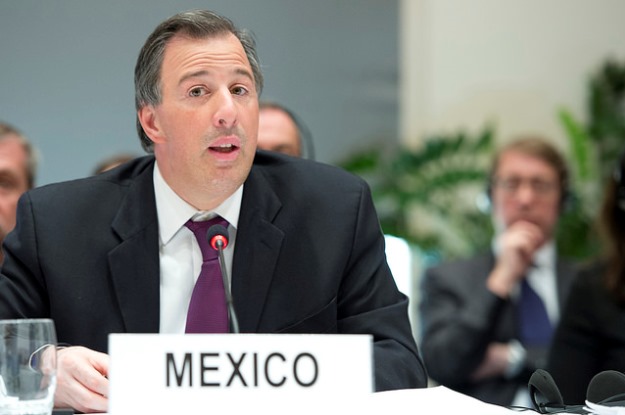It’s fair that Mexican officials would fret over U.S. President Donald Trump’s threats to walk away from the North American Free Trade Agreement (NAFTA) – 80 percent of Mexican goods are currently exported to the U.S., and any change to the 23-year-old deal will surely be economically and politically disruptive. But other potential changes in U.S. policy could have just as much of an impact on Mexico’s ability to do business and attract new investment. Policymakers will only be able to respond to these threats by getting the country’s fiscal house in order.
Trump’s promised increases in defense and infrastructure spending – alongside lower tax rates – are not in themselves a threat to Mexico. A boost to the U.S. economy could even provide momentum for growth south of the border. But if Trump’s new expansive fiscal policy is achieved by lowering the corporate tax rate, as he has suggested, Mexican competitiveness could be at risk.
Today, companies in the U.S. pay a tax rate of 35 percent, plus the state rate averaging 4.9 percent. Mexico’s corporate tax rates are significantly lower—averaging around 30 percent—helping make it an attractive destination for multinational businesses. Trump has suggested the possibility of lowering the rate to 20 percent, which would undercut Mexico as a potential home for new investment.
The best response to policies aimed at keeping jobs and investment in the U.S. (from Mexico’s point of view) would be for Mexico to become a more robust player in the global economy. That would mean substantially improving productivity, generating a more skilled labor force and increasing access to capital. Unfortunately, creating the mechanisms to spur this kind of change wouldn’t be simple. This is especially true given the country’s current education system, which, among other shortcomings, offers few technology or English classes in public schools and focuses primarily on teaching through memorization. In any case, significant progress wouldn’t be achieved in the short term.
The “simple” Mexican response to a decrease in corporate tax rates in the U.S. would be to respond in kind – but that option appears unlikely under current circumstances. The Mexican government is in no position to lose tax revenue, first and foremost because it has neglected its fiscal balance in recent years and in the past decade has seen a marked increase in debt as a percentage of GDP. From the beginning of 2007 to the end of 2008 (the year of the global financial crisis), Mexico’s debt-to-GDP ratio rose from 21 to 30 percent. Fast-forward to the end of 2016 and the debt has risen even higher, to 47.9 percent. Though still not exceedingly high by regional standards, the rate of growth – almost 15 percent over the last four years – is worrying.
The past years have been challenging for the Mexican economy and recovery from the financial crisis has been slow. The fall in the price of oil has taken a big chunk out of government revenues; depreciation of the peso, which has increased the cost of debt incurred in dollars, hasn’t helped matters. Nor will the political calendar make tax changes easier to implement: 2017 is an election year in four states (including a governor’s race in Mexico state) and presidential elections are scheduled for 2018.
Trade negotiations would themselves present challenges, of course. The Mexican administration could threaten to diversify Mexico’s exports, but it would be empty rhetoric given the geographic proximity of the U.S. and Mexico. Mexico could and should aim to diversify its imports – but with substantial political change likely within the next 18 months (the governing PRI party is highly unlikely to maintain control over the presidency, according to early polls), negotiating teams will need to make deals that they and their counterparts on the other side of the table know the next administration will honor. That won’t be a simple task – especially with Andrés Manuel López Obrador, who recently said that NAFTA was “neither panacea nor salvation” for Mexico, emerging as a frontrunner for the presidency.
Undoubtedly, Mexico faces an adverse climate vis-à-vis its northern neighbor, with no immediate relief in sight. President Enrique Peña Nieto would be able to react strategically if the country was better prepared to resist economic shocks—if public finances had been better taken care of, if structural reforms had been completed on time, and if the benefits of free trade had been better spread throughout the country.
The options at hand may help Mexico respond to changes under Trump, but there is little room to maneuver. Diversifying imports, especially of agricultural products, could put Mexico in a better position for eventual negotiations with the U.S. on trade, but that will take time. To weather the impending storm from the north, Mexico should have built itself a better house.
—
Moy is the director of México ¿Como Vámos? and an economics professor at the Autonomous Institute of Technology (ITAM). You can follow her on Twitter at @ValeriaMoy






